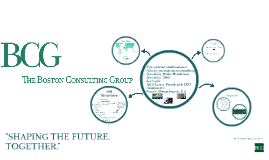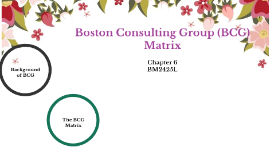BCG
Transcript: One of the dimensions used to evaluate business portfolio is relative market share. Higher corporate’s market share results in higher cash returns. This is because a firm that produces more, benefits from higher economies of scale and experience curve, which results in higher profits. Nonetheless, it is worth to note that some firms may experience the same benefits with lower production outputs and lower market share. High market growth rate means higher earnings and sometimes profits but it also consumes lots of cash, which is used as investment to stimulate further growth. Therefore, business units that operate in rapid growth industries are cash users and are worth investing in only when they are expected to grow or maintain market share in the future. Dogs hold low market share compared to competitors and operate in a slowly growing market. In general, they are not worth investing in because they generate low or negative cash returns. But this is not always the truth. Some dogs may be profitable for long period of time, they may provide synergies for other brands or SBUs or simple act as a defense to counter competitors moves. Therefore, it is always important to perform deeper analysis of each brand or SBU to make sure they are not worth investing in or have to be divested. Strategic choices: Retrenchment, divestiture, liquidation Developed by the Boston Consulting Group in the early 1970s, the BCG Matrix is a tool used to assist firms in determining how to allocate their resources in relation to product lines. Although the BCG matrix was designed to be used with products lines, it has applications for a variety of other settings. Presented by Ms.Tidarat Jariyakul 57123442162 Ms.Rawinnipha Daengsoemsiri 57123442166 Ms.Thanwa Ni-arvorn 57123442169 Ms.A-pissara Rongkaew 57123442178 Ms.Rojareck Rujireck 57123442179 Ms.Ploymanee Somnoi 57123442182 There are four quadrants into which firms brands are classified Market growth rate Stars Relative market share Cash cows are the most profitable brands and should be “milked” to provide as much cash as possible. The cash gained from “cows” should be invested into stars to support their further growth. According to growth-share matrix, corporates should not invest into cash cows to induce growth but only to support them so they can maintain their current market share. Again, this is not always the truth. Cash cows are usually large corporations or SBUs that are capable of innovating new products or processes, which may become new stars. If there would be no support for cash cows, they would not be capable of such innovations. Strategic choices: Product development, diversification, divestiture, retrenchment THANK YOU FOR YOUR ATTENTION Stars operate in high growth industries and maintain high market share. Stars are both cash generators and cash users. They are the primary units in which the company should invest its money, because stars are expected to become cash cows and generate positive cash flows. Yet, not all stars become cash flows. This is especially true in rapidly changing industries, where new innovative products can soon be out competed by new technological advancements, so a star instead of becoming a cash cow, becomes a dog. Strategic choices: Vertical integration, horizontal integration, market penetration, market development, product development Question Marks BCG growth-share matrix Cash Cows Dogs Question marks are the brands that require much closer consideration. They hold low market share in fast growing markets consuming large amount of cash and incurring losses. It has potential to gain market share and become a star, which would later become cash cow. Question marks do not always succeed and even after large amount of investments they struggle to gain market share and eventually become dogs. Therefore, they require very close consideration to decide if they are worth investing in or not. Strategic choices: Market penetration, market development, product development, divestiture

















